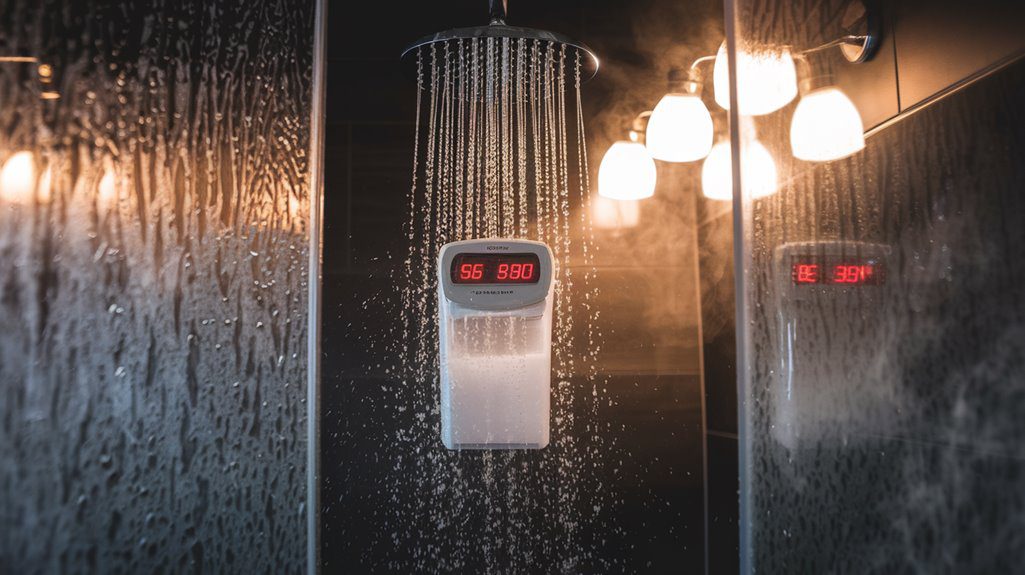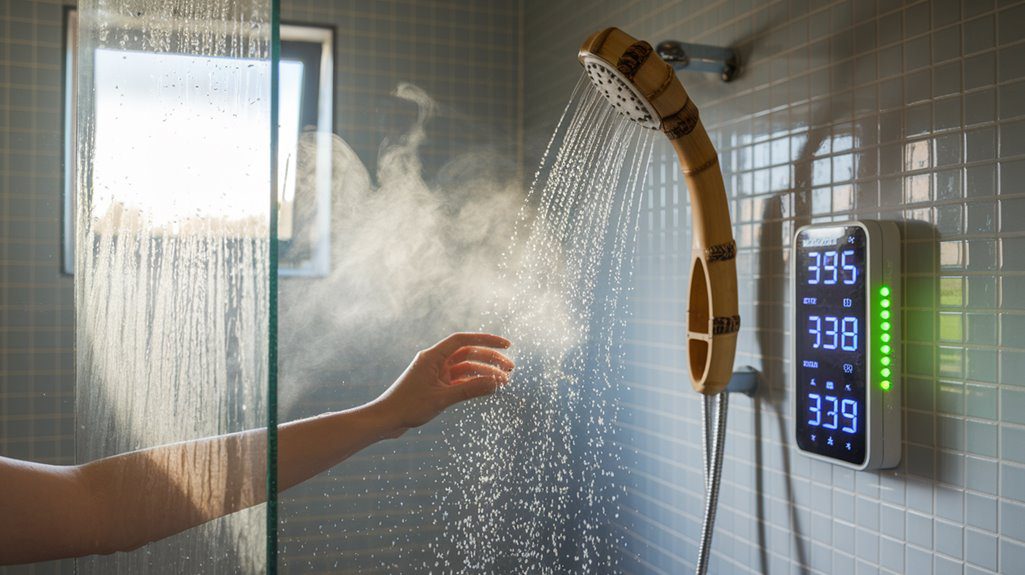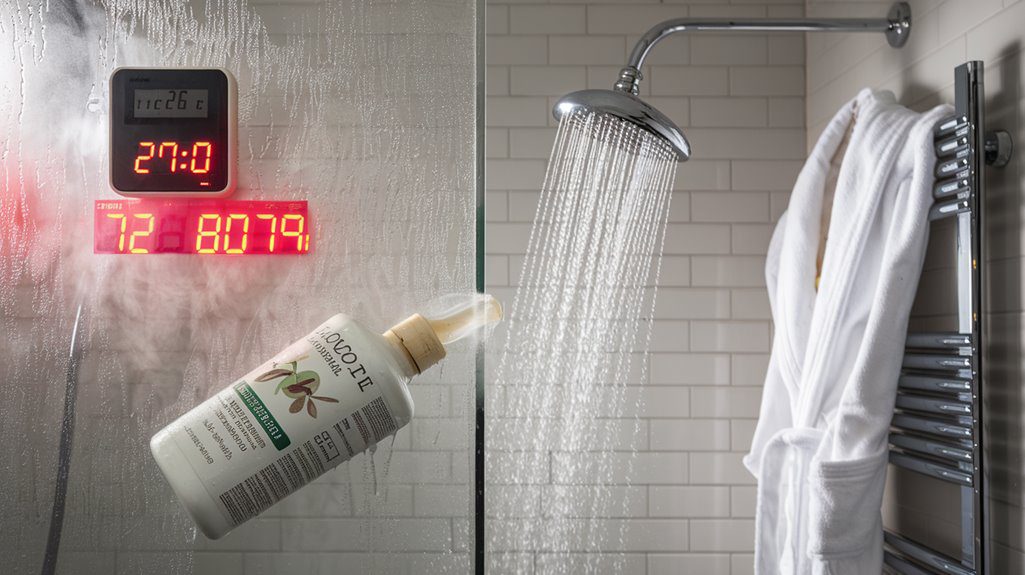Your Morning Shower Is Wrecking the Planet: See How You Can Stop It
Peek inside your shower's hidden environmental impact and discover simple changes that can help save our planet's precious resources.

Your daily shower greatly impacts the environment through multiple channels. Each 10-minute shower depletes 16-17 gallons of fresh water, generates CO₂ emissions equivalent to driving one mile, and releases harmful chemicals like parabens and microplastics into waterways. You can reduce this impact by installing low-flow showerheads, using biodegradable products, and optimizing shower duration. Smart technologies and sustainable practices offer even more powerful solutions to transform your shower's environmental footprint.
Article Highlights
- Install a low-flow showerhead to save 260 billion gallons of water annually and reduce your carbon footprint significantly.
- Limit shower time to under 5 minutes to halve your shower's CO₂ emissions and water consumption.
- Switch to biodegradable shower products to prevent harmful chemicals and microplastics from entering aquatic ecosystems.
- Replace gas-powered water heaters with heat pump systems to reduce emissions by 2,000 pounds annually.
- Use smart meters and digital monitoring systems to track and optimize water consumption, reducing usage by up to 60%.
The Hidden Environmental Cost of Your Daily Shower
While many people view their morning shower as a harmless daily ritual, research reveals significant environmental consequences lurking beneath the surface. Your shower products contain parabens, phthalates, and microplastics that flow directly into water systems, disrupting aquatic ecosystems and harming marine biodiversity.
Every time you use an exfoliating scrub containing microbeads, you're releasing thousands of plastic particles that persist in the environment. These microplastics, along with chemicals like triclosan, accumulate in marine organisms and work their way up the food chain, causing long-term ecological damage. Just like non-renewable resources, these harmful materials can take hundreds of years to break down. Even municipal water treatment additives like chlorine compound the problem when discharged into natural waterways.
You'll find that many products labeled "eco-friendly" still contain harmful additives. What's more, the frequency of showering varies globally, with Americans' daily shower habit creating a larger environmental footprint compared to cultures that shower less frequently, such as British and Japanese populations who average five showers weekly. Switching to biodegradable shower products can significantly reduce toxins in soil and groundwater while protecting marine ecosystems from harmful chemical exposure.
Breaking Down the Numbers: Water and Energy Impact

Beyond the chemical impact of shower products, the measurable water and energy consumption of daily showers presents stark numerical evidence of environmental strain. Your typical shower depletes 16-17 gallons of fresh water, contributing to significant resource depletion when multiplied across households and communities.
The flow rate of your showerhead directly correlates with environmental impact. Standard 2.1-gallon-per-minute fixtures accumulate substantial water waste over time, especially when you consider the cumulative effect of daily use. You're releasing thousands of gallons annually through your morning routine alone, placing unnecessary strain on local water treatment facilities and natural water sources.
This water consumption doesn't exist in isolation – it's intrinsically linked to energy use. You're using power to heat the water, pump it through your home's system, and process it at treatment facilities, creating a cascade of environmental effects.
How Your Shower Habits Affect Climate Change
Your morning shower ritual carries a surprising carbon footprint, as each 10-minute shower generates CO₂ emissions equivalent to driving your car for one mile. Water heating for showers consumes 15% of your household's energy, with gas-powered heaters producing 70% more emissions than electric alternatives. When you skip a shower, you'll reduce your annual carbon emissions by 310kg, making shower frequency a key factor in your personal climate impact. Installing a tankless water heater can significantly reduce your shower's environmental impact by providing on-demand hot water and eliminating standby energy losses. Upgrading to smart LED lighting throughout your bathroom can slash energy usage by up to 90% compared to traditional bulbs.
Daily Carbon Cost
Taking a daily shower contributes greatly to individual carbon footprints, with standard shower routines generating 109 kg of CO₂ emissions annually. If you're spending 10 minutes in the shower, you're doubling that impact to 220 kg CO₂/year. Your water heating system plays an essential role: a 5-minute shower with a gas boiler emits 90-200g CO₂, while electric systems release 500g CO₂.
You can notably reduce your shower's carbon impact by adopting WHO-recommended 5-minute showers, potentially saving 117 kg CO₂ annually. Installing a flow-restricting showerhead that delivers 9L/min maintains comfort while cutting emissions. Following the common practice in the UK, China, and Japan of showering five times weekly instead of daily further decreases your carbon footprint.
Water Heating's Climate Impact
The climate impact of shower habits extends far beyond individual carbon emissions, with water heating systems playing a central role in household energy consumption. Your home's water heating accounts for up to 32% of total energy use, mainly from fossil fuel combustion. By switching to a heat pump water heater, you'll slash your carbon footprint by 2,000 pounds annually. Making the switch to energy-efficient appliances can reduce overall energy usage by up to 50% in your home. Solar thermal energy systems offer an eco-friendly alternative by capturing the sun's heat directly for water heating needs.
| System Type | Energy Use (kWh/year) | CO2 Reduction (lbs/year) |
|---|---|---|
| Conventional | 4,500 | 0 |
| Tankless | 3,800 | 385 |
| Heat Pump | 1,500 | 2,000 |
| Heat Pump + Timer | 1,200 | 2,400 |
The environmental stakes are significant: if all U.S. households converted to heat pump water heaters, we'd eliminate 100 million tons of CO2 emissions annually—equivalent to planting 2.72 billion trees.
Smart Solutions for Eco-Friendly Showering

You'll maximize shower efficiency by installing smart meters that track real-time water and energy consumption, helping you reduce usage by up to 60% with low-flow showerheads like the Methven Aio Aurajet. Modern LED shower timers connected to apps can alert you when you've reached ideal eco-friendly duration limits, typically 4 minutes or less, saving 2.5 gallons per minute. Digital monitoring systems paired with dual-flow technology give you precise control over hot and cold water streams, enabling temperature adjustments that cut energy costs by 6% for each degree reduction. Installing faucet aerators in your shower can maintain strong water pressure while reducing flow to as little as 1.0 GPM. Energy consumption monitors can help track and optimize your shower's power usage throughout different seasons.
High-Tech Water Warriors
Modern shower technology has revolutionized water conservation without sacrificing comfort. Low-flow showerheads now operate at 2.0 GPM or less, potentially saving 260 billion gallons of water annually across the U.S. You'll find innovative features like mist cycle technology and pressure-compensated designs that maintain strong water pressure despite reduced flow rates.
Smart controls have transformed the showering experience through data-driven efficiency. You can monitor your water usage via smartphone apps, while thermostatic mixing valves automatically regulate temperature. Voice-controlled systems and automated shut-off features optimize your shower's performance during task-free moments. Built-in filtration systems simultaneously purify water and conserve resources, while multi-setting options provide customizable experiences. When combined with solar-powered heating and recirculation pumps, these technologies create an all-encompassing solution for sustainable showering. Following the zero-waste principles can further enhance your bathroom's sustainability by eliminating single-use plastic toiletries and containers.
Smart Meters Save Resources
While traditional water meters simply track total usage, smart metering technology has revolutionized resource conservation through detailed consumption analytics and real-time monitoring. The data shows you'll reduce your water consumption by 11-18% after installing a smart meter, with leak detection accounting for the majority of savings. These devices can spot household leaks within hours instead of the typical 14-day discovery period.
You're part of a larger solution when you adopt smart metering. In the UK alone, installing one million smart meters annually could save 1.4 cubic kilometers of water monthly, offsetting 30% of projected demands. The technology's impact is clear: Thames Water customers use 17% less water, while Anglian Water reports an 18% reduction in consumption, with smart meter insights driving behavioral changes. Smart meters represent a vital step toward conscious consumer behavior that supports long-term environmental sustainability.
The Economic Toll of Wasteful Shower Practices

Despite widespread awareness of water conservation, wasteful shower practices continue to exact a hefty economic toll on both individuals and society. Your daily 88-gallon water consumption, largely from showering, translates into significant utility costs, especially when combined with infrastructure inefficiencies that waste over 3,000 gallons annually per faucet. The financial impact extends beyond personal expenses, as treatment plants struggle with doubled workloads and increased energy demands.
Wasteful shower habits drain both personal finances and community resources, making water conservation a critical economic necessity in today's world.
- Property values drop up to 10% without water-efficient fixtures, while sustainable buildings command 20-25% higher rental rates
- Fines ranging from $41-$248 during water crises penalize non-compliance with conservation mandates
- Infrastructure maintenance costs soar as aging systems leak 20% of pumped water, straining municipal budgets
Your shower habits directly influence these economic pressures, with global implications intensifying as 50 countries face projected water shortages by 2025. Smart water management isn't just environmentally conscious—it's financially essential.
Transform Your Shower Routine: Practical Steps
Taking control of your shower routine requires calculated adjustments backed by measurable outcomes. You'll need to implement time-based modifications, starting with limiting showers to 4 minutes, which cuts water waste by 30 gallons daily. Install a low-flow showerhead that maintains pressure while reducing flow to 2.5 gallons per minute.
Switch to bar soaps, which require 80% less production energy than liquid alternatives, and adopt 2-in-1 products to minimize lather time. You'll maximize efficiency by investing in smart fixtures like Oasense showerheads that reduce flow to 10% when you're not directly under them. Install temperature-adjusting valves to standardize water heat and reduce energy consumption.
Track your progress using smart meters to monitor water and electricity usage. Consider reducing shampooing frequency to weekly intervals, and simplify your routine to minimize rinse cycles. These changes, combined with greywater collection systems, can transform your shower's environmental impact.
Beyond Individual Action: Community Solutions
As individual water conservation efforts multiply across households, community-scale solutions offer exponentially greater impact through systematic change. Local governments can implement leak detection technology in public water systems, reducing waste by up to 10% annually, while smart meters provide real-time usage data to track neighborhood consumption patterns. Through public-private partnerships and tiered utility pricing, communities can fund large-scale conservation projects and incentivize responsible water use.
- Retrofit programs offering $100-$200 rebates for low-flow fixtures and smart irrigation systems can transform residential water consumption
- Community-led initiatives like DIY rain barrel workshops and "Water Wars" competitions between neighborhoods drive engagement while reducing per-home usage by 5-10%
- Multi-stakeholder taskforces can coordinate greywater reuse ordinances and streamline permit processes for green infrastructure projects, maximizing impact through collaborative governance
Together, these community solutions create lasting infrastructure changes while fostering a culture of conservation through data-driven decision-making and collective action.
Frequently Asked Questions
Does Shower Water Temperature Affect Hair and Skin Health?
Your shower's temperature greatly impacts health: hot water (>105°F) strips natural oils and damages hair cuticles, while ideal temps (98-105°F) protect your skin barrier and maintain scalp balance.
How Often Should People Shower for Optimal Hygiene?
While 2/3 of Americans shower daily, you only need to shower 1-2 times weekly for basic hygiene. You should increase frequency with heavy exercise, targeting key areas like armpits, groin and feet.
Can Hard Water Impact the Environmental Footprint of Showers?
Your hard water showers increase environmental impact through 20-40% higher energy use, 40-50% more detergent consumption, extended shower times from reduced flow, and frequent fixture replacements due to limescale buildup.
Are Bath Bombs and Shower Steamers Environmentally Harmful?
You're releasing harmful pollutants when using bath bombs and steamers, as they emit 0.25kg CO₂ per 100g, contain microplastic glitter, and release synthetic fragrances that contaminate waterways through wastewater systems.
Do Water-Saving Showerheads Increase Risk of Bacterial Growth?
Yes, you're facing higher risks with low-flow heads. They generate more respirable aerosols (2-5 µm) and harbor denser bacterial colonies, especially in 1.0 gpm models versus standard 1.5-2.0 gpm designs.
Conclusion
You're now equipped with data showing how a single shower contributes 2.1 kWh of energy consumption and uses 17.2 gallons of water on average. While these numbers might seem insignificant, they compound across billions of daily showers worldwide. By implementing the water-saving techniques and technologies outlined above, you'll reduce your shower's environmental impact by up to 65% annually, marking a vital step toward climate resilience.
References
- https://www.swansea.ac.uk/press-office/news-events/news/2024/03/study-shows-more-powerful-showers-can-be-better-for-environment.php
- https://www.kellogg.northwestern.edu/faculty/bray/doc/opns450/homage.pdf
- https://www.envynature.org/how-your-daily-hot-shower-affects-the-environment-and-what-you-can-do-about-it/
- https://www.airuniversity.af.edu/Portals/10/AUPress/Books/b_0137_ackerman_future_trends.pdf
- https://www.epa.gov/sites/default/files/2017-02/documents/ws-ourwater-shower-better-learning-resource_0.pdf
- https://playitgreen.com/sustainable-showers-101clean-and-green/
- http://www.susted.com/wordpress/content/dissecting-the-average-shower-and-its-impact-on-the-planet-an-invitation-to-collaborate-part-one-human-water-usage-and-global-impact_2020_03/
- https://speed.readwise.io/articles/2a.html
- https://www.natgeokids.com/uk/discover/science/nature/how-to-save-the-planet/
- https://blog.advanced-showers.com/embrace-the-four-minute-shower
- http://www.keepblountbeautiful.org/blog/2018/10/30/how-your-morning-routine-is-harmful-to-the-environment
- https://www.mrgscience.com/uploads/2/0/7/9/20796234/ess_example06_e.pdf
- https://www.bbva.es/en/general/sostenibilidad/soluciones-para-personas/huella-de-carbono-personas/repositorio/ducharse-a-diario.html
- https://www.pawprint.eco/eco-guides/how-to-reduce-carbon-footprint-morning
- https://solve.mit.edu/challenges/climate-ecosystems-housing/solutions/62034
- https://www.hansgrohe.com/magazine/sustainability/showers-co2-consumption
- https://eta.lbl.gov/publications/our-environment-hot-water-comparing-water-heaters-life-cycle-approach-comparing-tank-and-tankless-wa
- https://newbuildings.org/this-earth-day-invest-in-a-heat-pump-water-heater-and-do-the-equivalent-of-planting-a-tree-or-a-forest/
- https://philbarnettplumbing.com/environmental-impact-of-heat-pump-water-heaters/
- https://www.greenmountainenergy.com/en/blog/green-living-and-more/eco-friendly-shower-guide
